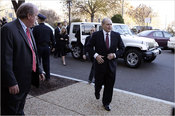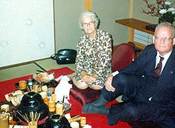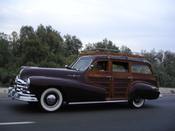
What follows are three favorite aphorisms of Detroit's carmakers, often heard at media events like new car introductions (and while "aphorism" is not a new car name, it's not half-bad, and certainly competition for these, all of which have actually been used: Mirage, Charade, Naked and Precis):
1) "Yes, we've had some problems, but we really expect our dropping market share to stabilize at some point, and we'll soon start reclaiming those consumers who want to buy American cars and trucks!"
2) "Our own American-built gas/electric hybrids and hydrogen-fueled fuel cell EVs are just around the corner!"
And my personal all-time, long-time favorite:
3) "Wait'll next year!"
Which makes the Detroit Three the Chicago Cubs of Cars.
Now they're blackmailing Congress: If you don't give us the money, they say, over six million Americans will be unemployed; it will put the big "D" in recession, as in, "Depression."
We've had enough threats from our sworn enemies; we don't need them from Detroit executives. These CEOs and their boards of directors must go, whether by car or jet or skateboard, they must go.

(Chrysler CEO Robert Nardelli arrived in style at the US Capitol, in an EV Jeep his company first displayed just a couple of weeks ago; Chrysler's only gas/electric hybrids are the Dodge Durango and Chrysler Aspen Hemi hybrids, but the Delaware factory where they are produced is closing at the end of this month).
None of these three classic fat-cats, GM's Rick Wagoner, Chrysler's Bob Nardelli and Ford's Alan Mulally, has ever shepherded any vehicle from concept to showroom; two of them spent their most-formative working years outside the auto industry.
Blaming their decades-long corporate problems on the UAW is outrageous, sleazy class warfare.
People working on the assembly lines, union member or not, can build a product only as good as its plans, and Detroit Three plans come from white-collar employees and are approved by scores of other executives before production begins.
Everyone in America, especially Detroit's three CEOs, should google the name Dr. W. Edwards Deming. He was the American statistical quality control genius who the Japanese say "created" their auto industry and helped make its products so often near-perfect.
At UCLA in the mid-1980s, I spent several hours interviewing Deming over three days, while also attending one of his already near-fabled management seminars. Deming explains what's right with Japan's carmakers, and what was and still is wrong with Detroit - an old-school "trickle down" corporate pyramid with one feared, strong personality at the top (Detroit CEOs) and those below receiving, at best, mixed, missed or misunderstood messages.
Deming was honored by Japan's Emperor with the highest prize given to any non-Japanese; in Japan, the most-coveted and well-known award for the company with the best quality practices is the Deming Prize.
It's hard to believe that in just the past two weeks these Detroit CEOs have had the many epiphanies they've reported to Congress. Next they'll be driving to Lourdes for advice.

(Left to right on couch, Mulally, Nardelli and Wagoner, then Dick Cheney, looking just smashingly evil and other-worldly in this shot and Pres'den' W. The now well-known CEOs of GM, Ford and Chrysler met with President Bush several months ago, but the current administration steadfastly refused Detroit's plea for help from the $700 billion Troubled Assets Relief Program, the TARP fund; some view the President's inaction as intending to hurt the UAW by forcing the union to make even more concessions to management).
They still take no responsibility for their car-selling problems by holding responsible, tight credit keeping customers from buying Detroit-made cars and trucks. And always, somehow, the UAW is also to blame.
If the current tight credit market is such a singular problem, why did all three companies start lobbying Washington for -- and receive written assurance for -- $25 billion well over a year ago?
Ford wants to draw on a government-provided $9 billion "line of credit," but only if and when it's needed.
If they may not even need the money, why are they asking for $2 billion more than they asked for just two weeks ago?
If the failed structures of these companies, including their executives and boards of directors, remain in place, giving or loaning our money to them is a foolish, frightening idea.

(GM CEO Rick Wagoner addresses Congress two weeks ago. As an aside, clicking on this photo turns it into a momentarily entertaining piece of op-art, and if you know what op-art is, you're either my age or older, or younger, well-read and very hip).
I say merge the three into one. One company can fully-utilize all the money from Washington or elsewhere, but there must also be tough government oversight and a board of directors made-up of the best automotive minds in the world. And hire a futurist, too.
This new, leaned-out carmaker could also build passenger rail cars for high-speed interstate trains, for low-speed local light-rail, new subway and monorail systems and the infrastructures for them all.
In Japan, I once glanced at a small metal plate on a Bullet Train, and it said, "Built by Hitachi." If Hitachi can build Bullet Trains, so can Detroit (and yes, I know, "Shinkansen" doesn't translate into "Bullet Train," so save those particular comments; but if you do know what Shinkansen means, go ahead and comment! Could be a prize in it for the first winner ... ).
Hydrogen-fueled fuel cell EV busses and vans of all sizes and types must roll off the lines, too. Many hydrogen-fueled EV busses are in daily operation throughout Southern California.
(This is a refrigerated flower bouquet dispensing machine on a side street in Narita, Japan, another fun one to click on and enjoy. We've seen iPod vending machines at the Hilton Hotel in Las Vegas, but this one is even more impressive; often, it's the little things that say a lot about a nation and its culture).
Use of solar cells, wind- and ocean- and lake- and river-generated power can all be assessed, improved and put into use.
No longer a car company but now a transportation/energy company, partially supported by government funding, as in many other countries.
Or should one -- or more -- of the three fail? In this 100th year of General Motors' existence, is it simply Detroit's time?
(This is a very rare 1948 Pontiac Silver Streak woodie wagon, caught on the I-10 outside Palm Springs, CA, and is a classic example of some of the best in American car production; apart from the incredible amount of labor which went into selecting, cutting, staining, bending and attaching all the wood parts, these cars were also rock-solid dependable. Along the line, some of that was lost by Detroit. Can they get it back? Is it worth our time, money and trouble?).
Have the Wagoner, Mulally and Nardelli Washington Follies helped form or change your opinion one way or another? Do you believe these companies can produce the cars and trucks America - and the world - truly needs? And when?
The national unemployment rate is now 6.7%. Two million Americans have lost their jobs this year, one-half million in November alone.
Can America afford -- or not afford - to save its domestic auto industry?
How should Congress vote next week?
Some photos (c) 2008 www.SteveParker.com


